In this article, we will take a look at using a roller crimper for organic no-till soybean production and the results of on-farm trials conducted in Ontario from 2019 to 2021.
Highlights
- Organic no-till soybean production was evaluated at 22 locations (13 observational sites and 9 replicated strip-trials)
- Organic no-till soybeans yielded 32.4 bushels/acre on average in strip-trials, which was 21.1 bu/ac less than soybeans grown with either tillage or herbicides used for weed control
- Organic no-till soybeans at observational organic sites averaged 39.2 bu/ac
- Cover crop-based organic no-till soybean production can be done successfully in Ontario, but it is not yet recommended on a large scale
- Best practices include early rye seeding, high soybean seeding rates and the use of seeding equipment appropriate for very high residue conditions
Why organic no-till?
Organic soybean production relies on a significant amount of tillage. When done well, strong yields can be achieved. There are drawbacks, however, including a high labour demand in the spring and the potential for soil degradation over time. Cover crop-based organic no-till soybean production techniques have been developed in recent years and proven to work in parts of the US. The question is: will they work under Ontario’s climate and soil conditions?
Cover crop-based organic no-till soybean production uses a roller crimper, a drum with chevron-shaped blades (Figure 1) that crimps rye (or another suitable plant) once it’s flowering and kills it. Soybeans are seeded into the mulch. If it’s thick enough, the mulch provides season-long weed suppression. The cover crop-based organic no-till system offers advantages in terms of labour savings and soil health improvements but comes with additional management considerations.
Ontario trial
On-farm experiences with organic no-till soybean production in Ontario over the past decade have yielded mixed results. As part of a three-season OSCIA Tier 2 trial, Heartland Soil and Crop Improvement Association evaluated cover crop-based organic no-till soybean production using best practices. The goals were to evaluate performance, identify barriers to success and develop Ontario-specific recommendations.

Nine replicated and randomized strip-trials were used to compare organic no-till soybeans to standard production practices in 2019, 2020 and 2021. Thirteen observational field sites were also monitored. At all sites, rye was seeded on an angle (> 20 degrees) relative to the direction of roller crimping and soybean seeding. Common cereal rye was drilled in September or early October across the sites and seeded at a rate of 3 bushels/acre (168 lbs/acre) for the strip-trial sites.
Seeding rye early is key
The most consistent observation made across project sites was the importance of early rye seeding. Rye was seeded following early-harvested crops such as small grains, sweet corn and corn silage. Trial sites seeded before September 22nd achieved more than 5,500 lbs/acre rye biomass (dry), while those seeded after were consistently below that threshold (Figure 2). A thick, competitive stand of rye is critical for the organic no-till system to work. In nearby New York state, achieving >6,000 lbs/acre of rye biomass has been identified as critical for successful weed suppression1.
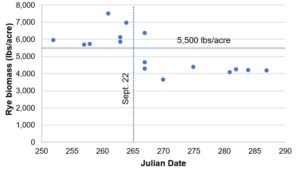
Vigorous spring growth is also important for competition with weeds. The Drayton-2020 site, which had high fertility and was seeded on September 20th, had good early season canopy coverage (Figure 3) and reasonable biomass (5,700 lbs/ac). As a result, it provided excellent season-long weed control (Figure 4).
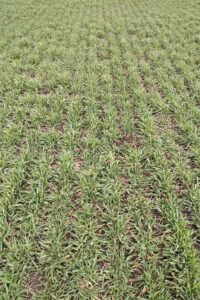

The Elora site (Figure 5), which was lower fertility and seeded on October 2nd, provided only 4,400 lbs/ac of biomass and its mulch was not able to hold back strong witchgrass pressure (Figure 6).

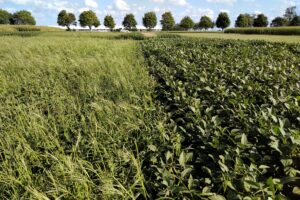
Use appropriate soybean seeding equipment
Another major finding was the importance of appropriate soybean seeding equipment for the high-residue conditions of this system. We had success (see example in Figure 7) using a planter set up for no-till conditions with sufficient down-pressure, sharp openers and appropriate closing wheels. Although no-till drills were generally successful as well, one site had a patchy stand because the drill could not effectively cut through the mulch (Figure 8). Most cooperating farmers had success drilling soybeans into standing rye before crimping. Planters are more likely to be effective in high rye biomass conditions and when the rye is crimped before soybean seeding.
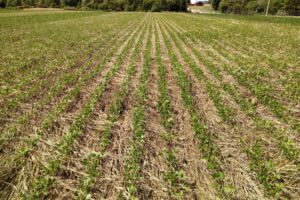
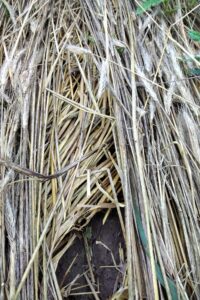
Seed soybeans thick
Soybean seeding rates for the organic no-till strip-trials were 200-250,000 seeds/acre in 2019. In 2020 and 2021, they were increased to 300,000 seeds per acre. Higher rates in the organic no-till system help to ensure a competitive stand, compete with weeds and provide yield improvements according to research from New York state2.
Seeding rate trials completed in 2021 confirmed the value of high seeding rates in the organic no-till system in Ontario (Table 1). Organic no-till soybeans seeded at 300,000 seeds/acre provided the highest yield at Bornholm and at Elora (numerically only). Averaged across strip-trial sites in 2020 and 2021 seeded at 300,000 seeds/acre, average plant stand for the no rye control was 23% higher (240,000) than the roller crimper treatment (195,000).
Table 1. Soybean population and yield by seeding rate at Bornholm and Elora sites in 2021. Statistically significant differences amongst treatments at the same site are shown by different letters.
| Seeding rates (seeds/acre) | Plant population Bornholm | Yield (bu/ac) Bornholm | Plant population Elora | Yield (bu/ac) Elora |
| 175,000 | 93,000 | 40.9 A | 107,000 | 32.0 A |
| 250,000 | 135,000 | 49.9 B | 166,000 | 38.3 B |
| 300,000 | 174,000 | 54.2 C | 216,000 | 42.8 B |
Rye mulch delays soybean growth and development
Roller crimped rye creates a cooler, darker environment at the soil surface that reduces weed seed germination. Those same conditions also slow the early growth and development of soybeans in the organic no-till system.
At the strip-trial sites, soybeans planted into roller crimped rye typically lagged one growth stage behind the no-rye control throughout the season. The difference is shown at the Drayton-2019 site in July (Figure 9). By mid-to-late August the roller crimped soybeans typically came on strong and canopied fully (Figure 10), though they remained shorter and matured later than the no-rye beans.
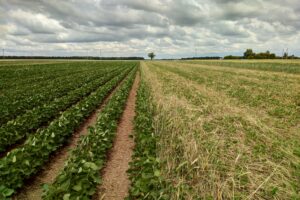
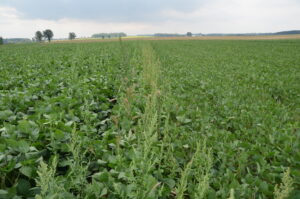
In 2020, due to dry conditions made worse by rye transpiration before crimping, moisture-limited soybean plants in the crimped plots remained strongly stunted relative to their no-rye counterparts. This large difference remained through to the end of the season (Figure 11); plants at most sites were only half to two-thirds as tall right up until harvest.

Yield results
Strip trial sites
The average yield across strip trial sites in 2019, 2020 and 2021 for organic no-till soybeans was 32.4 bushels/acre, which was 21.1 bu/ac less than the no-rye control yield of 53.5 bu/ac (Table 2). The difference in yield was greatest in 2020 (25.8 bu/ac) and least in 2019 (11.5 bu/ac). Organic no-till soybeans yielded the highest in 2021 – 43.6 bu/ac across two strip-trial locations. Note that only the Drayton sites were managed organically for the no rye (control) treatment; all other control treatments were managed using herbicides and seed treatments.
While insufficient mulch and weed pressure, as well as soybean stand damage from crimping, were factors at a couple of sites, they did not fully explain low yields achieved under organic no-till. The Drayton and Seaforth sites in 2020, for example, had acceptable weed suppression, but both yielded below 25 bu/ac. It’s believed that dry soil conditions due to below average precipitation in May, June and July were exacerbated by the cereal rye. This, in turn, severely stunted vegetative growth, root development and limited yield potential. Soybeans in roller crimped treatments in 2020 had a 30% lower pod count of those in the no rye treatment. Slightly smaller seed size likely further contributed to reduced yields.
Observational sites
Cover-based organic no-till yields at observational sites ranged from unharvestable in 2019 to a high of 55 bu/acre in 2021 (Table 2). The average soybean yield across all observational sites was 39 bu/ac when the Blyth site was not included. Sharp openers, increased down-pressure and a higher soybean seeding rate may have helped in overcoming some of these barriers at the unharvestable Blyth site. As with the strip-trial sites, it’s believed that soil moisture depletion by the rye contributed to the yield reduction in 2020. Reasonably strong yields in 2021 showed the potential of the system to be competitive with tillage-based organic production.
Table 2. Summarized yield results from all sites. All values corrected to 13% moisture. ST = strip trial; O = observational site. Statistically significant differences are shown by different letters.
| Site | Yield (bu/ac) No Rye |
Yield (bu/ac) Roller Crimped (No-Till) |
| 2019 | ||
| Blyth (O) | – | 0* |
| Drayton-2019 (ST) | 45.4 A | 36.8** B |
| Elora-2019 (ST) | 48.8 A | 34.5 B |
| St. Marys J (O) | – | 38 |
| St. Marys M (O) | – | 47 |
| 2019 Average (strip-trial sites only) |
47.1 | 35.6 |
| 2020 | ||
| Bornholm-2020 (ST) | 60.7 A | 33.2 B |
| Drayton-2020 (ST) | 46.9 A | 22.9 B |
| Elora-2020 (ST) | 66.2 A | 19.3 B |
| Seaforth (ST) | 35.3*** A | 24.9 B |
| St. Marys D-2020 (O) | – | 30 |
| St. Marys H-2020 (O) | – | 32 |
| St. Marys J-2020 (O) | – | 28 |
| St. Marys M-2020 (O) | – | 35 |
| Woodstock (ST) | 53.0 A | 32.7 B |
| 2020 Average (strip-trial sites only) |
52.4 | 26.6 |
| 2021 | ||
| Bornholm-2021 (ST) | 74.3 A | 48.0 B |
| Drayton-2021 (O) | – | 55 |
| Elora-2021 (ST) | 49.9 A | 39.2**** B |
| St. Marys H-2021 (O) | – | 43 |
| St. Marys M-2021 (O) | – | 35 |
| St. Marys R-2021 (O) | – | 49 |
| 2021 Average (strip-trial sites only) |
62.1 | 43.6 |
| Overall Average (strip-trial sites only) |
53.5 | 32.4 |
| Overall Average (strip-trial and observational sites) |
– | 36.0 |
*Soybeans at the Blyth site were unharvestable due to insufficient weed suppression, poor soybean growth and red clover re-growth.
**Approximately 18% of this yield is estimated to have come from rye seed
***Inadequate soybean stand
****Roller crimped soybeans received two applications of glyphosate in season for weed control
– No data
Lessons learned
Based on trial results over three seasons and multiple counties, cover crop-based organic no-till soybean production did not perform consistently. It is possible to grow a cover crop that can do a good job suppressing weeds, though this was not universally achieved. Early planting and good base soil fertility to support tillering and aggressive rye growth are key. Also, use of appropriate soybean seeding equipment is critical.
The below-average precipitation in the spring and early summer of 2020 exposed a key vulnerability of the system – resulting in disappointing yields, even in cases where everything else was done properly.
Based on observations from the past three seasons, the following lessons were learned:
- Select fields with low perennial weed pressure and at least moderate background fertility (e.g. >15 ppm P (Olsen), >100 ppm K)
- Seed rye early – ideally by mid-September – and thick to achieve sufficient rye biomass
- Use appropriate seeding equipment to ensure good cutting of the rye mulch, placement of soybeans, and closing of the seed trench
- Seed soybeans at a high rate (250,000-300,000 seeds/acre)
- Have a plan B if spring turns dry (take rye off as a forage, till it in or leave for grain)
Next steps
Additional observational sites will be monitored in 2022. In the future, earlier maturing varieties of rye, such as Aroostook and ND Gardner, will be compared to common rye. Comparison of the best crop types to precede rye establishment may also be pursued.
To read the full, detailed project report for 2019-2020 click here to visit OSCIA’s Tier 2 Projects website.
Acknowledgements
This project was supported by OSCIA Tier 2 project funding, provided by OMAFRA, as well as by the Canadian Agricultural Partnership, a five-year federal-provincial-territorial initiative. Financial support and statistical analyses were provided by the Ecological Farmers Association of Ontario’s Farmer-Led Research Program. Donations of cereal rye seed were generously made by Cribit Seeds and The Andersons (formerly Thompsons Ltd.). Soils at Guelph supported the Woodstock strip-trial site in 2020. Thank you to Matt Coffey, Pioneer Seeds, for donation of soybean seed in 2021.
Thank you to Horst Bohner and Mike Cowbrough (OMAFRA) for key project support. Finally, thank you to the farmer cooperators who made the project possible.
References
- Personal communication with Dr. Matthew Ryan, Associate Professor of Sustainable Cropping Systems, Cornell University.
- Jeffrey A. Liebert and Matthew R. Ryan “High Planting Rates Improve Weed Suppression, Yield and Profitability in Organically-Managed, No-Till Planted Soybean,” Weed Technology 31(4), 536-549, (1 August 2017). https://doi.org/10.1017/wet.2017.35
